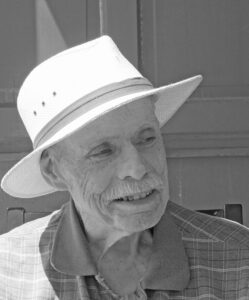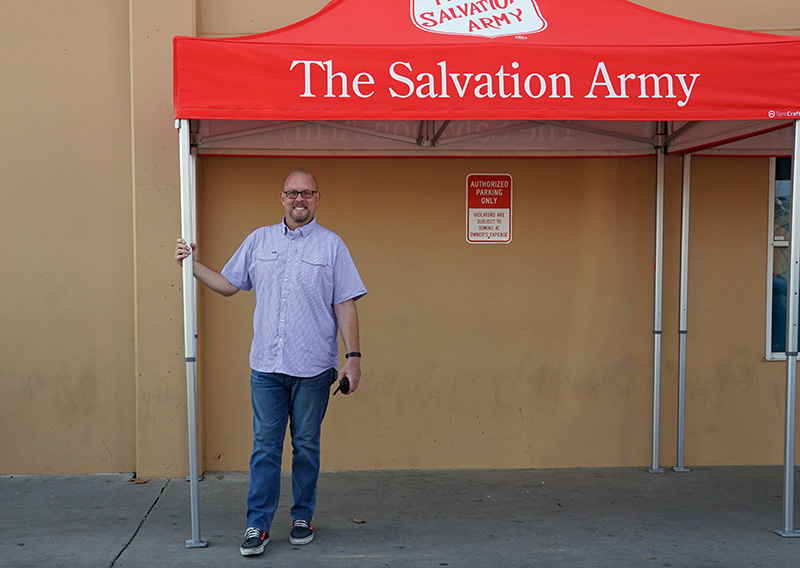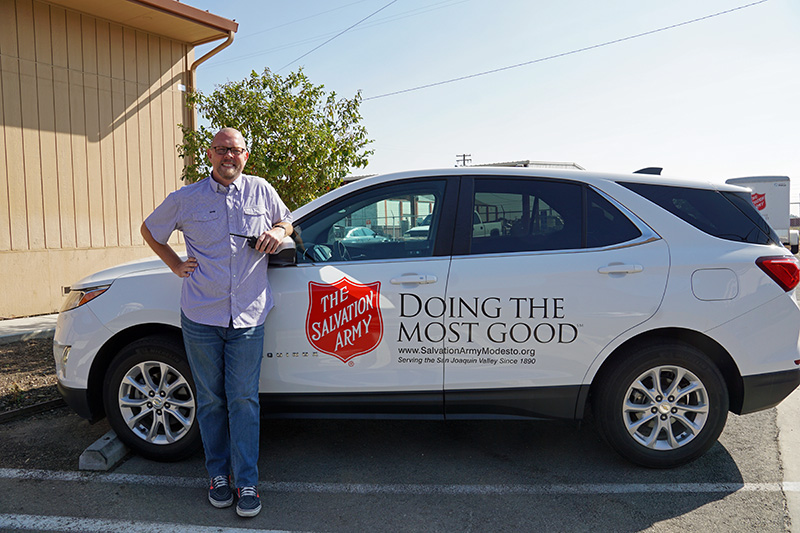
The island nation of Madagascar lies in the Indian Ocean off the southeastern coast of Africa, nearly 11,000 miles away from Modesto. But that’s exactly where Jim Stokes — Director of the Salvation Army’s Berberian Shelter and the Low-Barrier Shelter — dedicated a Peace Corps term to assisting the people of that island Republic. It was just one of many missions he has undertaken while trying to make a positive difference in the world. Prior to being hired by the Salvation Army in 2021, Mr. Stokes held various posts with the International Rescue Committee (IRC), first in Dallas, Texas, and then locally. Our community is highly fortunate to have him serving those among us who are most in need, since he brings such a wealth of experience to all that he does.
Q: You are leading a life remarkable for its service to others. What influenced you to follow that path as you were growing up?
Jim Stokes: I had a strong social justice upbringing, so I’ve been involved with nonprofits for as long as I can remember — but certainly starting in high school and continuing into college. Then I went into the Peace Corps and I’ve never looked back. I’ve never been somebody who wants to make a huge salary or not affect change in people’s lives. I’ve been exposed to a lot of marginalized groups across the board and that is my focus — to serve those people. I’ll serve them in any way possible. This opportunity (with the Salvation Army) definitely looks different than having worked with refugees, but both populations are sorely in need of attention and services.
Q: Your mission with the Peace Corps sounds very interesting. Please take a minute to describe some of the things you did while volunteering in Madagascar.
Jim Stokes: Sure. I was an Agroforestry volunteer in the southwestern corner of Madagascar, one of the farthest places away from the capitol. I lived in a small fishing village and worked on programs that addressed a lot of the local slash and burn practices, to generate pressure off the need to cut firewood and go out the next day and cut even more firewood. We also focused on alternative streams of income. I kept bees and I taught people how to make money from honey and beeswax products. I also taught people how to build stoves because often the villagers would cook by putting a pot on top of three rocks and lighting the fire underneath. We made the stoves from free local resources, like fresh cow dung, termite mound, and hay, and that had people using significantly less fuel, which meant that they didn’t have to spend as much time gathering firewood – which, in turn, cut down on deforestation.
Q: Then, after the Peace Corps?
Yes, after the Peace Corps, we came home – my wife and me. I had met my wife in the Peace Corps, where she, too, had been a volunteer. Back in the States, I worked for a program that took juvenile felons out into the woods for sixty days at a time to get them different training, different socialization opportunities, made them competent in skill sets that they had never had before like backcountry survival living. I also worked at a charter school in central New Mexico that had some university-bound kids but also Native American kids and kids from the town. I taught 4th grade, and there was probably a kindergarten to 8th grade span of ability among my students. I was exposed a lot to Apache and Navajo folks and heard about many of the difficulties they face in the 21st century.
Then, after getting my Master’s in International Peace & Conflict Resolution, I started my work with the IRC. During my tenure there I helped to significantly increase employment rates for refugees even during difficult economic times. I also helped bring the local Promature model to the IRC in Turlock for Afghan women.
Q: Briefly describe what you feel are some of the key issues our community must address when discussing local homelessness.
Jim Stokes: The really difficult bookends to our local homelessness problem is (1) the brutal systems that churn people through are only speeding up and not getting any better. Every year, people are surprised to learn that there are more homeless folks but how can you be surprised when nothing is changing, and things are only getting tougher? And then the other bookend is there is limited permanent housing. How do you put folks who lack a house into housing if the supply isn’t there and the current supply is cost-prohibitive for the majority of people? So that’s really difficult, for sure.

Q: Please briefly describe the shelters – the guests who use them, the services that are available, etc.
Jim Stokes: At the moment, there are about 180 guests in the Berberian Shelter, with 182 in the Low-Barrier Shelter. The majority of the folks in our shelters are over 5o years old and have various disabilities. Ours are not shelters full of young guys with drug problems — that represents an insignificant demographic of the population that stays here. I think people are generally surprised to learn that there is such an older population making up most of the folks who use our shelters’ services. Both shelters have access to 3 caseworkers, so each of them has a caseload of about 60 clients apiece. They work with their clients on all sorts of initiatives to move them forward, including mental health assessments, substance use referrals to treatment centers. They help with acquisition of ID’s and birth certificates. They help people get employment and to go back to school. Our case managers are jacks of all trade. They help with whatever the individual needs, which also includes referrals to permanent housing.
Q: As Director, what are some of your other duties?
Jim Stokes: I oversee roughly 400 people in both shelters, including the maintenance team, and the entire facility. I’m also charged with building new programs such as Safe Parking and the Day Center. I am also working with Healthnet and The Healthplan of San Joaquin on developing a short-term hospitalization program for our clients through CalAIM. And I’m the face of the shelters at public meetings.
Q: I understand that the Day Center is tentatively scheduled to be open by early November. Please describe what clients can expect once it is operating.
Jim Stokes: The Day Center will be in the common cafeteria between the two shelters. There will be charging stations there, and space for community partners to come and meet with folks who are guests of the Day Center. This is largely going to focus on the unsheltered population in Modesto. So, we’ll be providing services to a new population at our facility, 7 am to 7 pm, 7 days a week.
Our aim is to provide case management to them and access to a suite of services that will address their individual needs. We’ll also potentially be teaching things like harm reduction and life skills in classroom settings. It just depends on what the guests who are coming to the Day Center require at any given time. We’ll be surveying the guests regularly to make sure they are receiving the services and the programs that they need and want.

Q: Talk about how you interface with other community groups.
Jim Stokes: I don’t think it’s helpful to be siloed here with the Salvation Army when there’s so much work going on in the community that also supports our homeless population. I appreciate being held accountable by the community because that ensures that we’re moving forward and we’re doing right by folks. Joining MoCag and the Stanislaus Homeless Alliance and other groups is just an extension of knowing a lot of people in the community and wanting to be in the same room to have these vital discussions. While the problem is very similar to humanitarian crises I have worked on in the past, there are really a lot of folks who are committed to working on all the different facets of homelessness and trying to plug in all the different solutions that work for the many faces of our homeless community.
Q: Having worked in both fields and assisting thousands of people over the years, do you see a connective tissue between being a refugee and being homeless?
Jim Stokes: Yes. There is a connection. We are talking about the world’s most downtrodden people. There are two ways to look at them. One way is to look at them as a problem for society and a burden, and the other way is to look at them and say hey — we need to help these people because they are OUR community. There’s definitely enough money to go around — we’re the wealthiest country in the world. Let’s fix these institutional issues and problems: I’m a proponent of that solution.
Q: If you could convey one message to everyone who reads this article, what would it be?
Jim Stokes: Ever since I came to the Salvation Army I couldn’t be more happy to be in the right place. I’m really happy I’m able to do this day after day. My message is simple: All the unhoused people we talk about every day — they are your neighbors. Neighbors should be looked in the eye, shaken hands with, and asked what they need that day. I’m just looking for people to treat our homeless population more equitably, because when I look someone in the eye and genuinely ask how their day is, what are they moving towards, it has a massive impact on that individual. So, the flip side is also true. When you ignore them, or if you’re scared of them and cross the street to avoid eye contact, or if you look at them as THE problem that also is felt very strongly. If you had a choice between one over the other, why wouldn’t you choose the first?

Excellent! Sounds like the right person in the right place at the right time. My concern may seem trifling, but I see many homeless/unhoused people on the street with pets. I think they need this companionship. Some accommodation needs to be made for these folks and their animals.
The ACES shelter at Salvation Army does accept pets. Thanks for your feedback.
The low barrier shelter allows dogs or cats. The pet has a kennel near the bed of their person. The pet is provided vet care as well as food and supplies. It is an amazing program.
[…] Story continues […]
Tom Portwood,
Thank you for introducing the community to Jim Stokes, Director of the Salvation Army’s Berberian Shelter and the Low-Barrier shelter. Learning of his lengthy Social Justice background, from his youth through to this very day, abroad, within the US, and, now, right here in our own backyard, is quite “remarkable.”
Equally “remarkable” are the words Jim Stokes spoke in his revealing interview. His words moved me to reiterate a series of some which touched my heart, mind, and Spirit, as I recognized what his broad experiences have shown him, as follows:
“marginalized groups;” “my focus—to serve these people;” “sorely in need of attention and services;” “we are talking about the world’s most downtrodden people;” “the brutal systems that churn people through are only speeding up and not getting any better;” “I appreciate being held accountable by the community because that ensures that we’re moving forward and we’re
doing right by folks;” “My message is simple: All the unhoused people we talk about every day — they are your neighbors. Neighbors should be looked in the eye, shaken hands with, and asked what they need that day. I’m just looking for people to treat our homeless population more equitably, because when I look someone in the eye and genuinely ask how their day is, what are they moving towards, it has a massive impact on that individual.”
I ask in earnest for Jim Stokes to be bathed in daily prayer, in that he be gifted the wisdom, strength, resilience and favor to live up to his words, while bestowing goodwill toward our community comprised of all neighbors.
May Jim Stokes be successful in joining arms with fellow believers who are willing to develop their Church land, primarily, for the building of low income housing for those who desperately need permanent and/or temporary housing, they can afford to pay for. Perhaps, with rents on a sliding rent scale, so as their own income increases they will pay no more than a fixed maximum rent, so as not be dislocated because they improved their means. I would expect no less from the Church, yet can visualize even more.